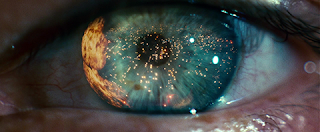Reality and Fantasy in Blade Runner, Metropolis, and the Metropolis
Are Roy’s and Rachael’s memories as authentic as that of a human being? Are the life and emotions they experience apart from their creator something entirely new and real, or are they just part of the fantasy? All of these questions are posited in a neon-drenched amalgamation of cultures, architecture and people. I find this sentiment reflective of Koolhaas’ text, “Life in the Metropolis”, and his notion that the creations of the modern metropolis are attempts to “establish fantasies as realities in the world” and that “they discredit the idea of Reality as an immutable and indestructible presence”. This vision of creating architecture to produce fantasy worlds for the people who designed it, is reminiscent of the decadent ‘utopia’ that the wealthy, like Tyrell, experience in Blade Runner. To maintain these false realities, they manufacture replicants (who experience an arguably more authentic and impactful reality than their own creator) as slaves to maintain the fantasy for the wealthy. Again I find a comparison to Koolhaas’ idea that as a city develops higher, so does the wealthy that follow it, and the “undesirable circumstances” get left behind along with the people in them. The buildings in Blade Runner like the Bradbury Building (a real building on the national register) are left in disrepair, for the “undesirables” like J.F. Sebastian to inhabit the wreckage, alone. Meanwhile his boss, Tyrell, is living lavishly on top of the city in his pyramid with artificial owls, beautiful robes, and a luxuriously soft bed.
This “Metropolis” that Koolhaas describes, full of “‘hysterical’ structures” with “unpredictable outcomes” would fail as they never address the whole, only the few. This “Metropolis” is also represented in the 1927 film of the same name. It’s no coincidence that Blade Runner draws heavy inspiration from Metropolis, both featuring massively layered cities, with the wealthy living in fantasy and the poor working their short lives away to service said fantasy.
The Eternal Garden of Metropolis sits atop the city (much like Tyrell's pyramid) for the children of the city leaders to frolic and play while deep underground the people tirelessly crank machines, which are only accessible by large elevators, the very same invention Koolhas credits as the proponent of modern metropolis.
Metropolis also features a fabricated human, the Machine Man, who is created (much like a replicant) to serve endlessly. These creations bring to mind Coney Island’s inexhaustible cow, completely regulated by human control.
















Comments
Post a Comment